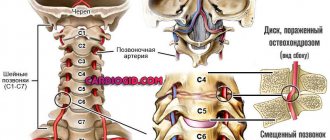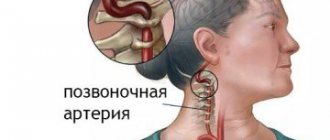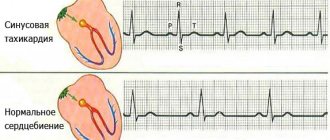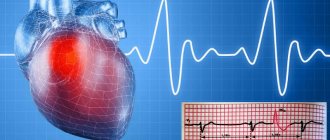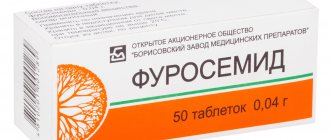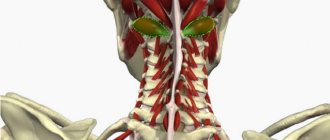Vertebral artery syndrome: symptoms and treatments
Vertebral artery syndrome (vertebrobasilar insufficiency syndrome) is a symptom complex caused by a disruption in the flow of nutrients into the brain cells due to pathology of the vessels located along the back of the neck near the spinal column.
A change in blood flow through the vertebral arteries causes headaches, especially in the back of the head, dizziness, blurred vision, and coordination of movements. The causes of the disease can be non-vertebrogenic (congenital anomalies, most often, small diameter of the vertebral vessels or atherosclerotic changes) and vertebrogenic (associated with spinal pathology), when the arteries are compressed from the outside by salt growths, deformations of the cervical vertebrae. However, in practice, a combination of these factors is very often observed.
Causes
Vertebral artery syndrome occurs in humans under the influence of two main groups of causes. This:
- Vertebrogenic causes mean diseases affecting the spine. These are injuries, tumors, and in adults, ankylosing spondylitis. But still, cervical osteochondrosis is in first place among the causes of the development of vertebral artery syndrome in humans.
- Not vertebrogenic, that is, not related to pathologies of the spinal column itself. These reasons include congenital anomalies in the development of one or two vertebral arteries at once; this may include excessive tortuosity or a decrease in size in diameter. Also, non-vertebrogenic causes are associated with atherosclerosis.
The main culprits of vertebral artery syndrome in cervical osteochondrosis are:
- Deviation of the vertebrae from their normal location.
- Inflammatory processes in the tissues of the neck. With inflammation, swelling occurs and puts pressure on the vessel.
- Muscle spasm in the cervical region. Muscle spasms in osteochondrosis of the cervical spine are caused by the body's reflex defense in response to pain and limitation of movements.
- Osteophytes, that is, the growth of bone protrusions on the vertebrae. This leads to mechanical compression of nearby vessels and mainly the vertebral artery. Osteophytes also constantly irritate the nerve plexus surrounding the vessel, which further increases arterial spasm.
Insufficient blood flow to the brain always leads to the development of characteristic symptoms.
What reasons need to be dealt with?
A feature of the anatomy of the vertebral arteries is their varying degrees of risk during the process of compression (narrowing). Before ascending to the cervical spine, the left artery arises directly from the aorta, and the right artery arises directly from the subclavian artery. Therefore, the left side is more susceptible to stenosis of atherosclerotic origin. In addition, an anomaly in the structure of the first rib (additional cervical rib) often develops here.
One of the main influencing factors is a change in the bone structure of the canal formed by the transverse processes of the thoracic and cervical vertebrae. The patency of the canal is impaired when:
- degenerative-dystrophic changes associated with cervical osteochondrosis;
- intervertebral hernia;
- proliferation of osteophytes in spondylosis;
- inflammation of facet (joints between vertebrae) joints;
- vertebral injuries.
These causes are classified as vertebrogenic, associated with the spine. But there are also non-vertebral factors that should be taken into account in treatment. These include:
- atherosclerosis of one or both vertebral arteries;
- abnormal narrowing or tortuosity (congenital hypoplasia);
- increased influence of sympathetic innervation, causing spastic contractions of the vessel walls with a temporary decrease in blood flow.
Bone canals provide protection for brain nutrition
Symptoms
Symptoms of vertebral artery syndrome begin with headaches that occur during sleep or with an uncomfortable position of the head. In addition, they influence the appearance of signs of injury or hypothermia.
This type of migraine has its own characteristics:
- The spread occurs to the temples through the back of the head.
- Various durations - from a minute to several hours.
- When palpating the cervical spine, unpleasant sensations arise.
- Often accompanied by dizziness, noise, numbness or fainting.
- The nature of the pain is varied: pulsating, contracting, bursting or shooting.
- A change in intensity occurs when changing position, but sometimes may not disappear.
Dizziness often appears after sleep. However, such a symptom may appear during the day. The dizziness lasts for a few minutes but can last for several hours. Due to dizziness, the patient experiences various symptoms:
- Noise in ears;
- Hearing and vision impairment.
Symptoms of the painful condition are also associated with a feeling of numbness. A similar symptom affects the upper limbs, neck area and part of the face. The reason for this phenomenon is problems with the blood supply to the areas.
With vertebrobasilar insufficiency, stenosis of one or both arteries occurs. If you bend your head for a long time, loss of consciousness may occur. Before fainting, the following symptoms occur:
- Facial numbness occurs.
- The patient feels unsteady in his position and becomes dizzy.
- Speech is impaired.
- Transient blindness occurs in one eye.
Pathological changes in vertebral artery syndrome also affect the patient’s mental state. Depression develops, which is associated with impaired blood supply to the brain. In addition, frequent attacks exhaust the patient, so psychological reasons also affect the condition.
Clinical picture
The main symptom of the pathology is considered to be a painful headache . In this case, a person may experience a burning pain syndrome that spreads from the back of the head to the temple, crown and superciliary area on a certain side.
In this case, the pain syndrome is constantly present. In rare cases, it is paroxysmal and worsens when walking or sleeping in an uncomfortable position.
Discomfort increases even with minor movements, but sometimes the patient finds a position where the pain completely disappears.
Many people complain of blurred vision . Sometimes pain occurs, visual acuity decreases, and veils or sand appear in the eyes.
There is also a risk of vestibular and hearing problems . Some patients experience hearing loss on a certain side and tinnitus. Many people complain of dizziness and loss of coordination.
Patients who have concomitant heart pathologies are at risk of developing cardiac symptoms. In this case, there is pressing or squeezing pain behind the sternum, which is acute. Attacks of high blood pressure may also occur .
As the disease develops, there is a risk of transient ischemic attacks, which are a transient circulatory disorder.
In such a situation, symptoms of motor problems, complete or partial loss of vision, and speech disorders arise. Patients often complain of problems with swallowing and loss of coordination. Some people experience nausea and vomiting .
It is worth considering that the manifestations of vertebral artery syndrome may resemble the clinical picture of an acute circulatory disorder in the brain.
Therefore, if the following signs appear, you should immediately consult a doctor:
- intense dizziness;
- visual impairment, double vision;
- headaches accompanied by nausea and vomiting;
- gait disturbances that appear for no noticeable reason.
Diagnostics
Suspecting vertebral artery syndrome is the task of not only a neurologist, but also a general practitioner. Based on the description of the symptoms, as well as examination data (tension of the neck muscles, pain when pressing on the processes of the cervical vertebrae and scalp), the doctor questions this diagnosis and refers it for instrumental examination.
It is carried out using several basic methods:
- MRI of the brain. Allows you to assess the state of the blood supply to the brain, identify areas of leukomalacia, ischemic foci, post-hypoxic cysts - that is, those complications that could result from a violation of trophism.
- X-ray of the cervical spine. Helps identify bone causes of the disease.
- Doppler ultrasound. It looks and is performed like a regular ultrasound and allows you to evaluate the anatomy, patency, speed and nature of blood flow in the arteries. It is this study that is fundamental for making this diagnosis.
Classification
Typing of vertebral artery syndrome (abbreviated as VAS) is carried out both according to the severity of clinical manifestations and the forms of the disorder, the main organic origin of the deviation.
The second criterion allows us to distinguish 4 types of disease:
- Angiospastic. There is a narrowing of the vertebral arteries with a deterioration in blood flow. Against the background of what this is developing, we need to find out separately with the help of instrumental studies.
- Compression. It is considered one of the main ones. The essence of the pathological process is the compression of the vertebral artery by third-party objects.
In the vast majority of cases, we are talking about muscles in a spasmodic state.
A common occurrence for patients suffering from osteochondrosis, athletes, people lying down for a long time or resting on an uncomfortable pillow.
- Irritative. The essence is a violation of the innervation of blood vessels. An abnormal signal is transmitted, which provokes stenosis of the vertebral arteries. This option occurs in approximately 10% of cases. Difficult to diagnose and distinguish from other forms of the disorder.
- Mixed variety. It is even more difficult to discover the essence of the pathological process. A comprehensive diagnosis is required.
The first criterion is more suitable for staging the disorder.
- Initial stage. Latent or hidden. The disease is mild, so there is practically no clinic, except for infrequent headaches and spatial orientation problems.
- Second stage. At this stage, it is quite easy to detect a deviation, provided that the person consults a doctor. But this most often does not happen. Therefore, the pathology progresses safely, leading to irreversible changes in the state of the brain.
- Third stage. Accompanied by a critical decrease in cerebral blood flow in the occipital region. The symptoms are neurological, severe, and impair the quality of life. Unable to carry out daily activities. The ability to work is minimal.
- Fourth stage. Usually precedes a stroke; after a few days, a maximum of weeks, an emergency condition occurs. Then there are two scenarios: disability with complete or primary loss of vision or death.
Classifications of SPA are used by practitioners to determine diagnostic tactics, therapy, and predict the likely outcome of vertebral artery syndrome (another name for the condition).
It is possible to divide the disorder into functional and organic (the difference in the persistence of manifestations).
Treatment of vertebral artery syndrome
As a rule, with cervical osteochondrosis, in most cases, complex treatment of the vertebral artery is used, combining medicinal and physiological methods of influencing the area where vascular damage was detected.
During periods of exacerbation of the disease, most experts recommend the use of a special collar - Shants. It is always selected taking into account the characteristics of the course of the disease and the general etiology of the detected pathology.
The compression collar perfectly reduces the entire load on the spine, especially in the posterior region. If the presence of vestibulo-cochlear syndrome is noted, the patient must be hospitalized in a hospital. Treatment should begin immediately after detection of this pathology. It is very important to choose the correct and most appropriate treatment in each specific case.
Shants collar
Medicines
The following groups of drugs are used to treat vertebral artery syndrome:
- Drugs that improve metabolism in cells: Trimetazidine, Mildronate.
- Anti-inflammatory. These medications are needed to treat the underlying disease (osteochondrosis, arteritis). Doctors prescribe non-steroidal anti-inflammatory drugs such as Celecoxib, Nimesulide, Lornoxicam.
- Decongestants. With cervical osteochondrosis or a hernia of the cervical spine, not only the vertebral arteries are compressed, but also the nearby veins. This disrupts the venous outflow of blood, resulting in swelling. To relieve it, doctors recommend drugs that improve venous outflow: Diosmin, Troxerutin.
- Neuroprotectors. They strengthen neurons (nerve cells) of the brain and prevent their death. Of the drugs in this group, Cerebrolysin, Actovegin or Piracetam are usually prescribed.
- Improving blood circulation. They stimulate blood flow in the vertebral artery, as well as in the small arteries and capillaries of the brain. A neurologist may prescribe you Pentoxifylline, Vinpocetine, Instenon, Cinnarizine, Vincamine or Nimidopine.
They also use medications to eliminate negative signs that interfere with a normal life.
Treatment
The therapy is conservative. Surgery is not resorted to, except in extreme cases, when there are indications and it is justified.
Several groups of medications are prescribed:
- Angioprotectors. Anavenol and analogs. Normalize the elasticity of arteries and prevent their destruction.
- Means for restoring blood flow and relieving spasms. Usually, a combination of Nimesulide and its analogues (non-steroidal anti-inflammatory drugs) and phlebotonics (Troxerutin) is effective. It is possible to use other combinations. At the discretion of the specialist.
- Nerve cell protectors. Including Mexidol, Sumatriptan.
- Means for restoring cerebral blood flow: Piracetam, Actovegin, Cinnarizine and others.
- Nootropics. Normalize metabolic processes. Glycine and others.
- Antispasmodics for relief of vertebral artery stenosis. Papaverine, Drotaverine.
- Muscle relaxants if muscle damage occurs.
- Be sure to take B vitamins.
Surgical methods are prescribed in extreme cases. The main indication is intervertebral hernia. The operation is also performed for certain types of column instability, if we are talking about an advanced case.
In addition to medications, massage is prescribed (except in situations where there are hernias), exercise therapy, and physiotherapy.
Treatment of vertebral artery syndrome lasts from 3 to 12 months.
Massage
It is prescribed starting from the subacute period of the disease. Its main goal is to relax tense neck muscles, which will help reduce compression (squeezing) of the vertebral arteries.
Unprofessional implementation of massage techniques can lead to the development of very serious and life-threatening complications: pulmonary embolism, complete compression of neck vessels with the development of syncope, or even stroke.
Exercises for vertebral artery syndrome
Therapeutic gymnastics is prescribed to patients after a course of massage. The first lessons are held with an instructor. He explains exercise techniques to patients. There should be no unpleasant sensations during gymnastics.
Exercises for vertebral artery syndrome:
- turning the head to the sides (up to 10 times);
- tilting the head back and forth (up to 10 times);
- shoulder lift (5 times);
- circular movements of the head (up to 10 times);
- displacement of the head back and forth on one plane (up to 10 times);
- moderate back pressure with your hand in different directions (up to 10 times).
All exercises are done smoothly and softly; sharp jerks and turns are contraindicated. Classes should be temporarily stopped if an exacerbation of the disease begins.
Forecast
Many people wonder whether vertebral artery syndrome can be cured. A favorable outcome is possible only if all medical recommendations are followed.
To do this, you need to regularly take vascular medications and follow safety rules that will help avoid attacks.
If treatment is not started in time, there is a risk of dangerous complications. These include ischemic damage to brain tissue due to disruption of the supply of oxygen and energy to the nervous system.
Lifestyle change
For a full course of treatment, doctors recommend changing your attitude towards familiar things:
- reduce salt intake with food;
- if necessary, quit smoking and lose weight;
- adjust your work and rest schedule, get enough sleep;
- if there is a high level of cholesterol in the blood, you need to reduce the amount of fat consumed;
- be less nervous, and if stressful situations develop, use sedatives;
- To relieve pain, it is recommended to wear a Chance collar at home, and, if possible, at work, which reduces the load on the cervical spine.
Drug therapy
In the treatment of vertebral artery syndrome, a complex of drugs is used that affect the patency of the artery and extravasal pathology.
The most important drugs are non-steroidal anti-inflammatory drugs. They cause anti-inflammatory, analgesic effects by inhibiting the migration of neutrophils to the site of inflammation, in addition, they reduce the ability of platelets to stick together and form blood clots. From the entire group, drugs are selected that are least toxic to the patient’s stomach and intestines. These include:
- Nimesulide,
- Meloxicam,
- Celecoxib,
- Aceclofenac (Aertal).
Airtal is a new drug in this series, its toxicity is 2 times less than Diclofenac.
Muscle relaxants - centrally acting drugs are used, they relieve increased tone, muscle cramps, and reduce pain. Applicable:
- Tolperisone,
- Baclofen,
- Mydocalm.
Of these drugs, Mydocalm has the greatest analgesic effect. By reducing muscle spasm, it simultaneously activates blood circulation.
For acute symptoms, drugs are prescribed intramuscularly.
Vasodilators or vasoactive drugs such as Cavinton, Trental, Instenon can improve microcirculation in ischemic neurons of the brain. They act at the level of metabolic activation and provide energy to cells by accumulating ATP. At the same time, vascular tone and the ability of the brain to regulate its own blood circulation are restored.
Medicines to activate metabolism in brain cells:
- Glycine,
- Piracetam,
- Actovegin,
- Cerebrolysin,
- Semax.
They eliminate tissue hypoxia and have antioxidant properties. Treatment courses are carried out for 3 months twice a year. If necessary, synthetic antioxidants are prescribed: vitamins A, E, C, drugs Ionol, Phenosan.
Symptomatic remedies - according to indications, sedatives and antidepressants are used. For dizziness, Betaserc is prescribed. It is not recommended for long-term use.
Physiotherapeutic methods
In the acute phase of the disease, physiotherapy helps block pain impulses along sympathetic nerve fibers. For this we use:
- diadynamic current for 5 minutes;
- ultrasound in pulsed mode;
- phonophoresis with solutions of Analgin, Anestezin;
- electrophoresis with ganglion blockers;
- d'Arsonval's currents on his head.
In the subacute stage, you can use electrophoresis with iodine, Novocaine, Euphyllin, Papaverine.
Reliable physiotherapeutic methods include: acupuncture, galvanization of the collar area. An individual mode of pulsed currents and ultrasound is also selected.
Folk remedies
Therefore, together with massage, medications and physiotherapeutic procedures, various folk remedies can be used.
- Pine baths are good for relaxing and relieving muscle spasms.
- A tincture of grated garlic, honey and lemon juice improves blood circulation and thins the blood. You need to take it one tablespoon before bed.
- A decoction of sunflower roots helps remove salts from the body, which are often deposited on the vertebrae during osteochondrosis. A liter of this decoction is drunk per day.
- A compress of grated horseradish effectively relieves pain. The paste of this root is placed on a linen napkin on the neck area, covered with cellophane and wrapped warmly.
- Brew oregano: 2 tablespoons of herbs per liter of boiling water. Infuse all night, drink in four doses the next day. This infusion is good for dizziness.
Prevention
Preventive measures against vertebral artery syndrome and cervical osteochondrosis are very simple. It is important to lead an active lifestyle, not to overload the spine, and spend less time sitting. For treatment to be effective, you need to slightly adjust your daily routine and reduce some stress.
An important attribute of such an adjustment will be morning exercises. You need to give up bad habits, minimize sitting time, and move more. It is necessary to keep your back straight and not slouch, then your neck will be healthy.
What it is?
Vertebral artery syndrome (VAS) is a complex symptom complex that occurs when the lumen of the vertebral artery (VA) decreases and its periarterial nerve plexus is damaged. According to the collected data, in practical neurology, SPA occurs in 25-30% of cases of cerebral circulatory disorders and is the cause of up to 70% of TIAs (transient ischemic attacks).
The most significant etiopathogenetic factor in the occurrence of the syndrome is the pathology of the cervical spine, which is also widespread. Its high prevalence and frequent occurrence among working-age populations make vertebral artery syndrome an urgent social and medical problem of our time.

